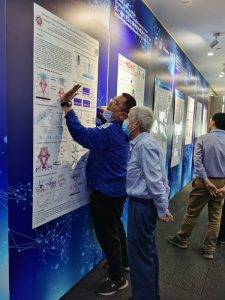Finally, we were able to have a group outing and played live-action CS games.
GBA Biophysics Forum
Dr. Chen SONG was invited to give a talk at “The First Great Bay Area Biophysics and New Drug Discovery Forum” on April 10, where he presented our recent story on the valence selectivity of ryanodine receptors. Dr. Yang WANG presented a poster of our NompC work at the forum, which attracted much attention.

Aihua is leaving
Sadly, Dr. Aihua ZHANG is leaving the group for family reasons. Aihua was one of the first members who joined me to build up the group. He has contributed so much to the group, not only in developing the new calcium model allowing us to simulate calcium-permeating ion channels, but also in helping group members in so many different ways. It has been a great pleasure to work with Aihua. We wish him all the best in every aspect of the future.

Presentations at the 65th BPS Meeting
Lei WANG, Chunhong LIU, and Yang WANG presented their work as posters at the 2021 BPS meeting (Feb 22-26), respectively. Chen SONG was selected to be one of the four speakers in “The Future of Biophysics Symposium“, a great honor from the biophysical society annual meeting!
Happy NIU Year!
A PSI Seminar
Dr. Chen SONG was invited to give a seminar at the PSI seminar series on Jan 20: https://mp.weixin.qq.com/s/byAxfC4VTIQZCxI0j4QbIQ
The PSI seminars are organized by Profs. ZHENG Weimou, GONG Haipeng, and BU Dongbo, mainly focusing on computational studies of protein structures.
Lei won the CQB scholarship
Jiaxuan passed the Qualifying Exam
Seminar by Prof. XU Dong
Invited by Dr. SONG, Prof. XU Dong from the University of Missouri-Columbia gave us an online CQB seminar entitled “Graph Neural Networks to Learn Long-range Interactions in Proteins from Molecular Dynamics Simulations” on Jan 11, 2021. Around 140 attendees participated in the event, and it’s very interesting to see how graph neural networks can be used to identify the allosteric pathways from MD trajectories.
Seminar by YANG Jianyi
We invited Dr. YANG Jianyi from Nankai University to give us a seminar at CQB on Dec 21. Jianyi is an expert in protein structure prediction, who developed the well-known software trRosetta. He also contributed to the development of I-TASSER. The seminar was entitled “Protein and RNA structure prediction based on deep learning”, and attracted much attention both offline and online.

